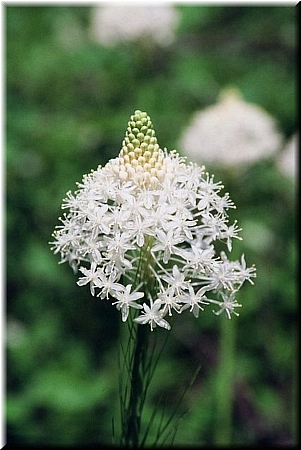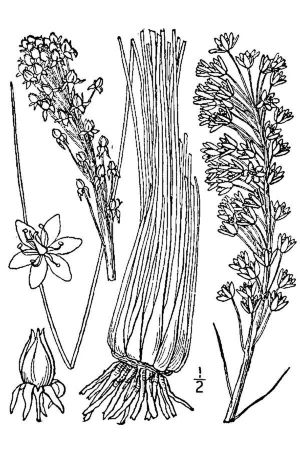Xerophyllum asphodeloides
 |
 |
Photo Courtesy Renee Brecht |
Britton & Brown |
| Botanical name: | Xerophyllum asphodeloides |
| Common name: | Turkey-beard |
| Group: | monocot |
| Family: | Liliaceae |
| Growth type: | forb/herb |
| Duration: | perennial |
| Origin: | native |
| Plant height: | 8 - 15 dm |
| Foliage: | long raceme of small whitish flowers, tepals 6, flowers perfect. |
| Flowering time: | late May to early July |
| Habitat: | low, sandy ground |
| Range in New Jersey: | Pine Barrens, Middle District |
| Heritage ranking, if any: | n/a |
| Distribution: |  |
| Misc. | Dense tuft of hard, narrowly linear
radical leaves. Stone says "Linnaeus states that he received the original specimen from 'Barthram' and as he was well known to live in Pennsylvania, the State is given as the type locality. Bartram, however, traveled frequently over southern New Jersey and undoubtedly got his specimens here." (340) McCormick says southward along the Appalachian mountains. "Xerophyllum asphodeloides is found in two disjunct habitats that share the same features of dry, acidic sandy or gravelly soils. These two locations are the pine barrens of Ocean County, New Jersey, and mid- to high-elevation (1000 m or 2000-3000 feet) quartzite or granite ridges with xeric oak-pine glades along the Appalachian mountains of Georgia, the Carolinas, Virginia, West Virginia, Tennessee, and Alabama. Both habitat types are dominated by various species of Pinus and Quercus with a sparse canopy, and a park-like understory with scattered shrubs and herbaceous species (including other rare and specialized species) that can tolerate dry, nutrient-poor conditions. In the mountains, these communities tend to occur on west or northwest-facing slopes, where the primary source of water to the system is rainfall and fog. According to reports from the U. S. Fish and Wildlife Service (1983), Mueller (2001), Rawinski et al. (1994), and the reports of other botanists, Xerophyllum asphodeloides tends to co-occur with: Quercus prinus (chestnut oak), Quercus marilandica (blackjack oak), Pinus echinata (shortleaf pine), Quercus stellata (post oak), Sassafras albidum (sassafras), Pinus rigida (pitch pine), Aster dumosus (aster), Aster paternus (white-topped aster), Cypripedium acaule (pink lady's-slipper), Polygonella articulata (jointweed), Solidago odora var. odora (sweet goldenrod), Solidago puberula var. puberula (goldenrod), Trichostema dichotomum (blue curls), Gaylussacia baccata (black huckleberry), Hudsonia ericoides (golden heather), Hudsonia montana (mountain heather) Ilex glabra (inkberry), Kalmia angustifolia (sheep laurel), Leiophyllum buxifolium (sand myrtle), Lyonia mariana (staggerbush), Myrica pennsylvanica (bayberry), Pyxidanthera barbulata (pyxie-moss), Quercus ilicifolia (bear oak), Rhus copallinum (winged sumac), Vaccinium corymbosum (highbush blueberry), and Vaccinium pallidum (hillside blueberry). Kuser and Zimmerman (1995) also record Xerophyllum asphodeloides from around the margins of Atlantic white cedar swamps in the New Jersey pine barrens." Center for Plant Conservation Genus Xerophyllum (xerox, dry, and phyllon leaf). Species asphodeloides (like Asphodel) |